Creating a secure space for your pooch while you’re away doesn’t have to be difficult. This guide outlines the necessary steps on “how to crate train a dog when you work” in order that everyone can relax knowing their canine companion is safe and sound. With some patience and preparation, establishing this comfortable environment will help ensure your pup feels content even if it’s just for brief periods of time throughout the day!
Key Takeaways
- Crate trains your dog with the right approach tailored to their age, temperament, and past experiences.
- Dog crates create a positive environment in the crate by providing treats, toys & praise plus using a motivating tone of voice.
- Balance crate time with regular exercise & playtime for successful training while enlisting help from professionals when needed!
Crate Training Basics for Working Dog Owners
The goal of crate training is to help your dog find the security and comfort they need in their den. The process should be tailored specifically for each canine, taking into account things like age, prior experience, and temperament. It’s important not to make them feel like being put away in a cage is a punishment. Instead, it has been designed with love by you so that it will become their own special space!
In a perfect world, you would have all the time in the day to dedicate to crate training your puppy or dog, but let’s face it…some of us have jobs! The crate training process requires patience, time, and dedication, and even though you spend a good deal of time away at work, that does not mean you cannot still have a well-adjusted crate-trained dog. The process just may take a little longer, but do not fret, this article will walk you through how to crate train your canine friend while still maintaining your day job!
Importance of Crate Training
Crate training has many benefits. It is a great way to use your dog’s den instinct for their comfort and safety. Providing them with enough room in the cage so they can stand up, turn around, and rest without crouching down will give them peace of mind during travel or while healing from an injury. Crates also provide safety, not only for your puppy but for your furniture and valuables as well. They are also key training tools for potty training a young canine.
Choosing the Right Crate
When it comes to training your furry friend, getting the correct crate is essential for their safety and comfort. Plastic or collapsible metal pens are offered in most pet stores. Make sure they have ample room inside so that puppies can stand up, move freely, and lie down comfortably. If you’ve got a pup that’s still growing fast then get one size larger and use dividers to open the crate up as they grow.
Create a warm atmosphere by adding blankets and cushions into the den as this will assist with making them feel more relaxed while also helping to reach ‘dream dog’ status quicker. Most pet supply stores have all the items you might need.
Meet: Silky Terrier
Preparing Your Dog for Crate Training While at Work
To ensure success with crate training, it is important that pups or adult dogs be given a positive experience and made familiar with their environment. This should begin by placing the dog’s crate in an area of high activity for your family such as a living room or lounge. Also, keep the door open during this early introduction period. By using pet cameras, you can conveniently monitor whether your puppy keeps quiet while away from his/her space – rewarding them promptly upon returning will create reinforcement towards any exemplary behavior!
Positive Association with the Crate
Crate training for puppies should be an enjoyable experience, so it is important to create positive feelings towards the cage. Give your pooch their favorite toy, treats, and lots of appreciation when in or near their designated space, which could ideally be somewhere the family spends a lot of time like a living room! It is not a bad idea to rotate the location, so your pup gets familiar with the whole house. Many owners even purchase two crates in order to keep one in the bedroom.
Soft dog chew toys, food puzzle feeders & interactive treat dispensers are great tools to motivate them within this environment. Utilizing a lighthearted yet soothing tone will also help develop rewarding emotions surrounding being inside the cage. Let’s not forget an incredibly comfy dog bed, soft blankets, and perhaps even an item from the breeder that has their mother’s scent.
To ensure success with the training procedures outlined remember key points such as providing encouragement each time they use their special area along with plenty of comfy items including Kongs filled with tasty surprises that make your pup love getting into the very same spot over again – happy times ahead!
Gradual Introduction
It is important to be patient when introducing your pup to crate training. Encourage them by speaking a cue word such as “crate” and offering them a treat with your hand directed towards the crate. Then let your dog briefly explore it on their own time frame at ease.
Play crate games like placing kibbles or dog biscuits near the crate then slowly start tossing them into the crate. You can even start using cue words like “crate” as they go in. As they get more comfortable or explore the crate naturally, hold off on giving them a treat until they go in.
Everyone’s journey will vary depending upon the dog’s age, temperament, and past happenings, but can take anywhere between days to weeks for complete adjustment within the confines of an enclosure like theirs!
Crate Training Steps for Busy Dog Owners
The successful process of crate training a puppy begins by introducing your pup to the space and associating it with pleasant experiences. It’s advised that you begin their journey into a comfortable, confined living area slowly – place food close then inside the enclosure and eventually moving the food bowl to the back of the crate.
In order to reduce stress levels associated with departures and arrivals at home, keep these activities low-key. If needed seek out assistance from friends, family or even your intended walker or pet sitter to add socialization to the process.
Feeding Meals Inside the Crate
During crate training, it’s best to start by placing the food dish close to your dog’s crate and then gradually relocating it into the space. With this strategy in place, you’ll want to observe how comfortable they are eating inside before shutting them inside with their meal. Once that is achieved, be sure to introduce exciting meal options like interactive toys or slow-feeding bowls as well as delicious chews and stuffed goodies filled with safe canine treats such as yogurt or peanut butter for puzzle toy stuffing purposes!
Increasing Crate Time
For an effective crate training experience, it’s important to be patient with your pup and give them time to adjust. Gradually allow for more time in the cage (even if only for a few minutes at first) so that they become comfortable while inside. Monitor their progress throughout the process and make any required alterations until you can both confidently say that all parties involved are relaxed during this activity!
Crating During Work Hours
When your pooch feels secure in its cage, you can start creating them during working hours. To make the whole experience less alarming for them, keep arrivals and departures fairly uneventful, this will help to lower any potential anxiety or stress levels. Place a pet camera around so that you are able to monitor how they’re doing while away from home.
If there is no sound coming from within the room after placing your dog in its crate, rapidly go back and praise with treats or verbal cheers in order to reinforce good behavior. Crating your four-legged friend when out of sight may ease anxiety and stop other destructive behaviors that could arise if left without being supervised at those times throughout day/night periods.
Meet: Silken Windhound
Integrating a Pen Until Your Pup is Fully Trained
For us working stiffs, we benefit from the fact that young puppies can sleep up to 18 hours a day. The downside is that the bladder matters and young puppies and older dogs alike will need a potty break. The below chart gives a breakdown of bladder hold time by age. If your working hours exceed this time or your puppy is not fully acclimated to their crate then you will need another approach.
Many dog owners combine dog pens, pee pads, or puppy proof rooms in combination with a crate if their working hours are not aligned with your puppy’s bladder. How this works is placing the dog crate in a puppy proof room and allowing them access to pee pads. You absolutely do not want them to start messing in their crate. If you do not have a safe room for this, then place the crate inside a larger pen, so that the pup can exit their crate to access a pee pad.
When you get home and on weekends continue the crate training process to increase the amount of time your pup can stay in the crate with the crate door closed, but while at work, ensure they are not crated for longer than their bladder can hold.
Addressing Common Crate Training Issues
Crate training a dog can be beneficial, but may also cause undesirable behavior such as whining or barking. To ensure successful cage training and avoid any issues, it is vital to understand the reasons why these behaviors occur in dogs while progressing through the appropriate steps of teaching. To this, recognizing signs of separation anxiety is very important for creating positive experiences with your pup. By going about the process gradually instead of doing too much at once, you will have far better results when involving crates during puppy education.
Whining and Barking
When it comes to your dog whining and barking in the cage, there are a variety of possible causes including boredom, loneliness, fear/anxiety or stress. To help alleviate this behavior, you need to provide them with plenty of exercise and mental stimulation as well as acclimate their time spent in the kennel by gradually increasing increments until they feel comfortable within it.
Patience is key throughout all steps. Positive reinforcement can be an effective way to calm any anxiety that may arise from being inside the enclosure. Remember when training your pup about proper behaviors while confined: consistency will go a long way!
Separation Anxiety

How to Crate Train a Dog when you Work
When it comes to separation anxiety in dogs, cage training can be useful but not enough. Factors such as past experiences, frustrations or becoming overly attached to their owners could cause these anxious behaviors. In order for your pup’s behavior to improve and manage the feeling better, you should provide a safe place like having them in the dog’s crate, which will also create an atmosphere of comfort along with interactive toys that serve as distractions while simultaneously desensitising them from certain cues signaling departure.
Having quality time together and balancing out some sleeping hours is key since it strengthens their trust in you so they feel reassured when alone during moments of distress related to separations!
Balancing Crate Time and Quality Time

How to Crate Train a Dog when you Work
Finding a good mix between crate time and playtime for your dog is very important. Providing adequate physical activities, games and contact with other animals are essential to guarantee the canine’s happiness as well as successful cage training. Creating an appropriate balance will not only be advantageous to their wellbeing, but also help them become better adjusted emotionally. By taking into account both of these aspects, you can make sure that your pet thrives in his home environment.
Exercise and Playtime
Working canines need an average of one to two hours a day in order for them to remain active and energized. Depending on the breed, they may necessitate more physical stimulation which might include extended periods of playtime or exercise as well as some mental activities like puzzles or obedience exercises while outside their cage. This will help maintain good health while reducing anxiety when being crated up – thereby providing contentment all-round! Interactive games played inside the box are advisable too.
Socialization Opportunities
Socialization is vital for the early development of your puppy’s social abilities and emotional well-being. This period usually ends around 4-5 months, but it’s recommended that you still give them brief opportunities to interact with others until they are a year old at least.
One way to help make this process enjoyable for everyone involved is by taking advantage of playdates, walks with other dogs or people in their life, doggy daycare or trips to the dog park. Activities like these will not only enhance your pup’s sociability but also prepare them better when crate training, including cage training puppies.
Providing plenty of opportunities for exposure before age one should set up your pet pooch well as he grows so even simple tasks such as leaving him alone (in his Crate) won’t be a problem due to lack of confidence from minimal interaction experience!
Enlisting Help When Needed
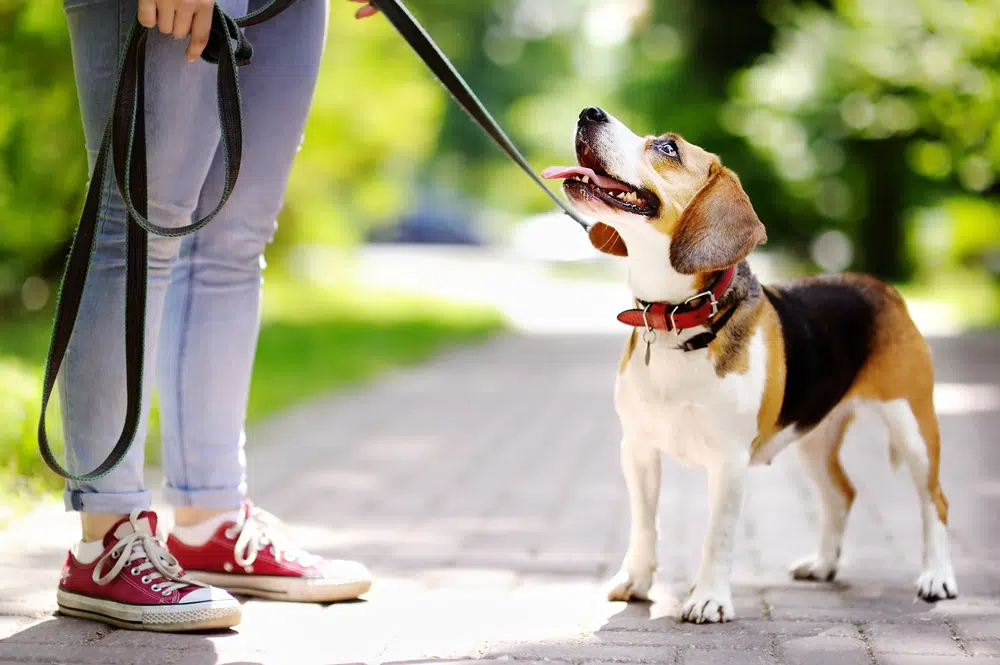
How to Crate Train a Dog when you Work
Mastering crate training may be demanding, but don’t worry – professional dog walkers or doggy daycare services are here to help. They can supervise your pup and make sure their needs are fulfilled when you’re not available. These professionals also keep up with the routine taught in the training process, as well as feeding them treats appropriately.
Investing in a pet sitter or taking advantage of these specialized centers is an effective way of showing love towards your four-legged buddy while ensuring they get ample practice for being crated at home too! So if you need assistance with teaching this habit to your fur baby, seek professional advice without delay!
Meet: Sloughi
Hiring a Dog Walker or Pet Sitter
When looking for someone to take care of your pet, you should make sure that they have an affinity with animals, know what they are doing thanks to their experience and references, can be trusted, and possess the necessary qualifications or training as well as insurance/bonding.
A competent dog walker should display love for dogs alongside commendations from prior customers – meaning any specific requirements set by you will be respected while also having enough expertise regarding canine behavior so potential issues won’t arise unexpectedly.
Doggy Daycare
A dog can benefit from attending doggy daycare with activities that involve socialization, supervised playtime and cognitive stimulation. Costs for such a service may range anywhere between $35 to $100 per session while some places offer discounted package deals. Enrolling your pup in these kinds of programs could be very beneficial as it will provide them with an opportunity to become socially adjusted and make the process of crate training much simpler. It’s also great for providing extra peace of mind when you are away at work knowing their needs have been met throughout the day!
Summary

How to Crate Train a Dog when you Work
Crate training your canine companion amidst a hectic work schedule may seem daunting, but with the proper plan and commitment plus assistance when needed, you can generate an atmosphere where both of you will be content. Using this guide as reference material will provide all the direction necessary to ensure their protection and joy while away from home, thereby creating a tranquil environment at home for everyone. Don’t forget: A pleased dog brings peace of mind into one’s house!
Frequently Asked Questions
1. Is it OK to crate your dog while at work?
Crating your canine companion during the day while you are away is a viable option as long as they receive adequate affection and freedom when you return home.
2. How do you crate train a dog when you work full time?
When teaching your puppy to be comfortable in its cage, a few steps must be taken. To ensure that the space is safe and enjoyable for him/her, start by introducing them to treats given inside their cage. Training requires consistency, when you feel they are getting used to being alone, gradually increase the times when he or she may stay caged without supervision. With patience and adherence, this kind of training can still succeed even if working full time!
3. When should I stop crating my dog at work?
When it comes to leaving your dog unattended, two years old is the recommended age as they have reached maturity by then. Before that time though, their behavior can be unpredictable, and crating them may be necessary in order for you to prevent any possible trouble while no one’s around.
4. How long does it take to crate train a dog?
Crate training your pup can take a bit of time and effort, depending on their age, personality traits, and history. This method demands patience as the duration of success could be days or even weeks. With commitment it is.
5. How much exercise does my dog need while crate training?
Crate training your dog requires up to two hours of exercise per day for them to stay energetic and healthy. This amount could vary depending on the type of breed, with working breeds needing more than that.
Interesting Reads:
Finding the Right Puppy Crate for Your Dog
Best Dog Breeds for Dove Hunting
Goberian: The Complete Guide to the Golden Husky Mixed Breed Dog

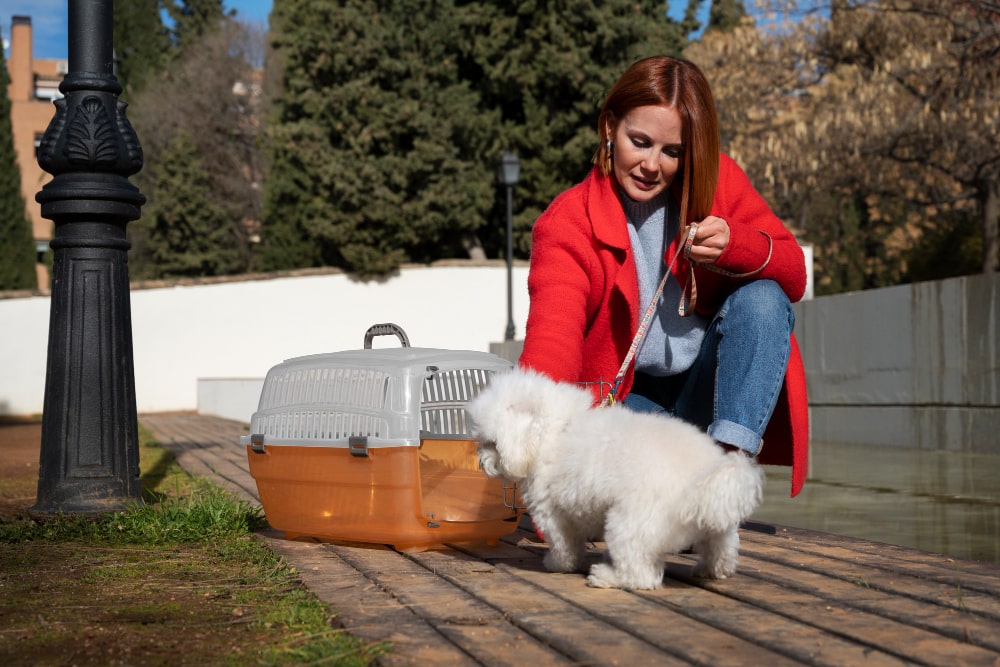
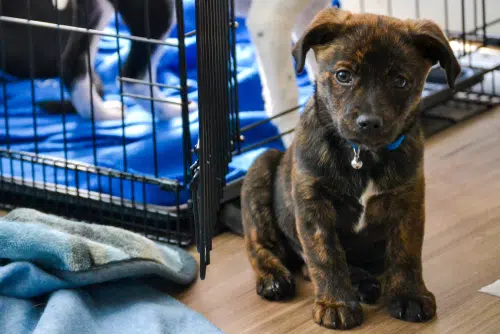
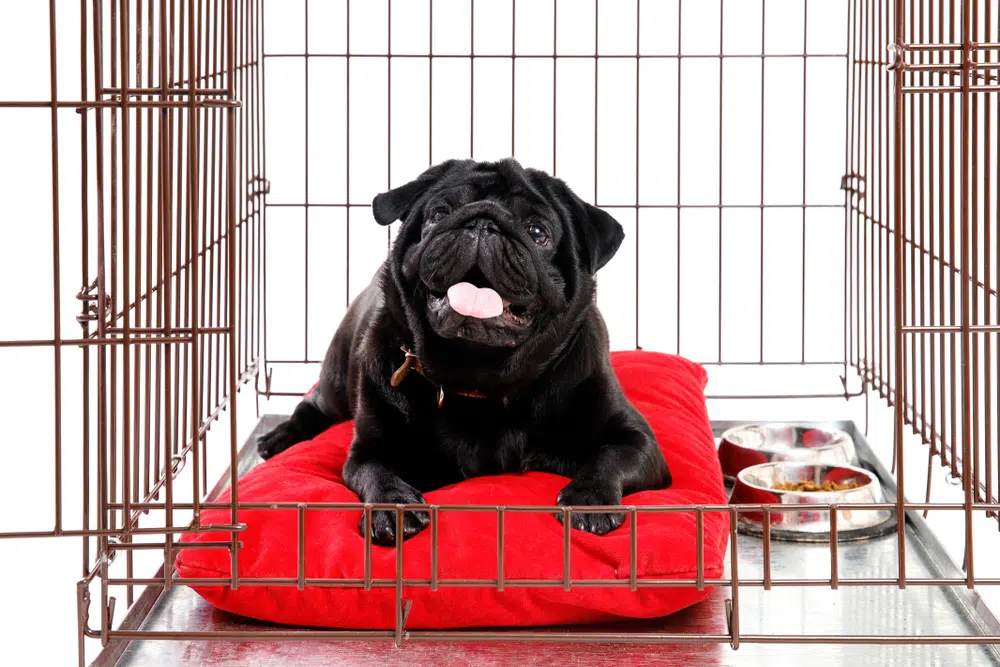
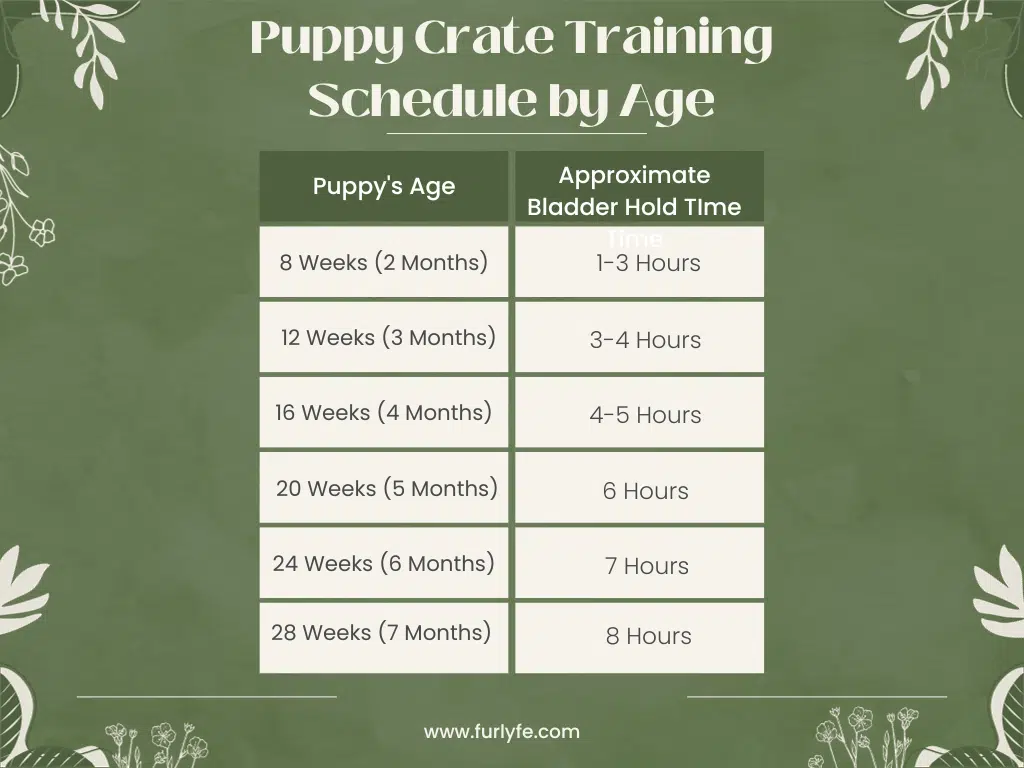


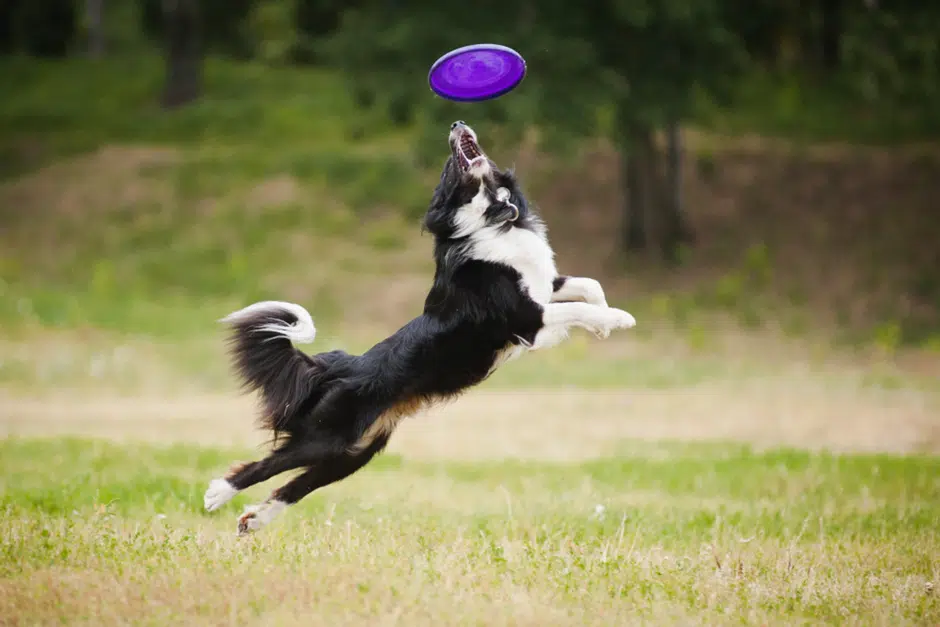




Get involved!
Comments